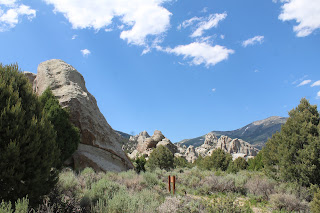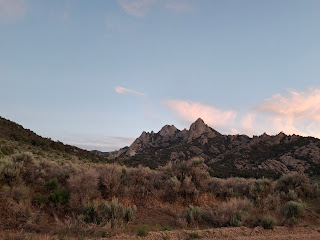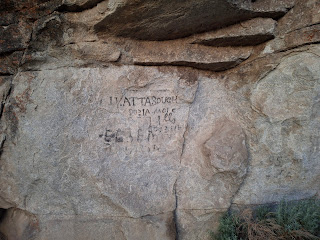The dry, uninhabited mountains of northern Utah seem an odd location for a momentous occasion. Along with mountains covered in light vegetation, a rocket facility and a massive solar panel farm are among the only residents.
But almost 160 years ago, this country was the home to a monumental shift in the United States.
The meeting of Leland Stanford’s Central Pacific Railroad (from Sacramento) and Thomas Durant’s Union Pacific Railroad (from Omaha) ushered in the post-Civil War settlement of the West.
With the connection of the two lines, everything changed. The march on Manifest Destiny would not abate until the 1890s, when the frontier was declared closed.
The continent was spanned. The wagon train era ended immediately. The great herd of bison was divided.
Settlers backed by the Homestead Act poured into Indian territory, ignoring that they were given land upon which people already lived. The trains also brought U.S. Army troops and resupplied forts more quickly, leading them to force most tribes onto reservations within the decade. That history is unbreakably tied to the transcontinental railroad’s connection.
Work on both railroads began in 1862, with the Civil War slowing progress significantly until 1865.
With the war over and soldiers from both sides returning to civilian life, the railroad brought opportunity for many. The Central Pacific was heavy on Chinese laborers, while the Union Pacific included war veterans, European immigrants, and freedman, recently emancipated slaves.
 |
| Golden Spike site |
The following four years included Indian raids, especially on the Union Pacific, and tent towns that follow the Union Pacific across its route.
The moving town was known as Hell on Wheels, offering railroad workers every sin imaginable – salons, gambling parlors, brothels, and more. There were churches and other services that travelled along. Some tent towns sprouted actual routes, with Cheyenne, Wyoming, and Reno, Nevada the best know.
There's a five-season Hell on Wheels series that depicts a highly fictionalized version of the Union Pacifc march westward; it's a worthy pulp take on a historic period that often gets overlooked.
As for why Promontory Summit, the railroads began to put down competing lines, Congress declared this the location for the railroads to meet.
Even the Golden Spike site would only have a brief prime. The linkage occurred near a steep rise in the grade, which could take trains up to 36 hours to top. Multiple trestles were built to bring the railroad through the mountainous terrain.
Eventual construction of a railroad causeway across the Great Salt Lake provided a faster route and resigned the Golden Spike location to history.
The historic park reenacts the trains touching at this point. They pulled close enough to where the final golden spike could be driven. Dozens of people in 1860s outfits gather to replay when a railroad first spanned North America. Replica trains drew within one railroad tie of each other. Each performance drew a crowd to a spot far from modern travel routes.
 |
| Solar farm below Promontory Summit |
So many canyons
Looks like I picked the wrong day for any Salt Lake City exploration.
 |
| Unreachable capitol |
The downtown attractions were not for the casual. Temple Square, head of the LDS Church, is under renovation through 2027. I thought I might sneak up for a walk around the state capitol, but its peaceful perch on a hill outside the downtown skyline hid its inaccessibility.
Auto traffic to the capitol was shut off for the tens of thousands of protestors out for No Kings demonstrations. Sidewalks were thick with people, volumes I could not have anticipated for a place as conservative as Utah.
I would not reach the capitol, and chose another course.
The Great Salt Lake region is largely smushed into the lower elevations between the Wasatch Mountains and the Great Salt Lake and other remnants of Lake Bonneville, which once covered the much of western Utah. The Great Salt Lake, Utah Lake, and Sevier Lake are all remnants of Lake Bonneville, which formed during a wetter age in Utah.
The rivers that form in the Wasatch Range flow into the Salt Lake metro through steep, scenic canyons.
I ended up in American Fork Canyon, which look remarkably similar to Logan Canyon from two days earlier. But I only had to trek a short distance up the American Fork Canyon. The canyons is a major recreation destination, with bikers, hikers, and runners occupying the canyon’s tree-filled lower reaches.
 |
| American Fork Canyon approach |
 |
| American Fork Canyon |
 |
| American Fork Canyon |
I stopped at the visitor center for Timpanogos Cave National Monument, which thankfully sold out its tours for the day. Reaching the cave tour requires a 3-mile roundtrip hike up to its mountain entrance. If reservations remained, it would have pushed my stopping point in western Colorado past dark. This cave requires a larger time commitment than most, so I knew I would have to try again.
From the town of Spanish Fork, the road runs up the Wasatch Plateau above the Spanish Fork River. No interstate directly connects Salt Lake City and Denver, leaving U.S. 6 as the most direct access. While it cuts through some high country, the route thankfully bypasses the San Rafael Swell, the scenic but townless stretch of I-70 west of Green River.
The road peaks at Soldier Summit before becoming subordinate to the wrinkles and turns of rugged Price Canyon. The lush green canyons along the Wasatch Front give away the red rock associated with Utah's river-carved national parks. Price Canyon receives protection from the BLM as Price Canyon Recreation Area. I had eyes on my campsite outside the Grand Valley, and pushed through the towns of Helper, Carbonville, and Price.
The last 50 miles to Green River were flat, windy and arid, brightened only by the arrival of the Book Cliffs to the southeast. At Woodside the Price River appears one more time before crossing into the canyonlands where it joins with the Green River.
The last stretch might have been flat, but mt thoughts still funneled through canyons, too much history and scenic spots to digest this quickly.
 |
| Spanish Fork |
 |
| Near Soldier Summit, I think |
 |
| Price Canyon |
 |
| Price Canyon |






















































